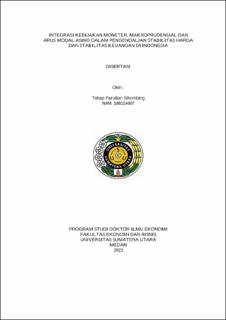Integrasi Kebijakan Moneter, Makroprudensial dan Arus Modal Asing dalam Pengendalian Stabilitas Harga dan Stabilitas Keuangan di Indonesia

Date
2023Author
Sihombing, Tohap Parulian
Advisor(s)
Hasyim, Sirojuzilam
Irsad
Ruslan, Dede
Metadata
Show full item recordAbstract
Under the influence of foreign capital flows, the study blends monetary policy and macroprudential policy to examine the effects on changes in price stability, exchange-rate stability, and outputs that impact financial stability. In monetary policy, the interest rate serves as an operational variable. Foreign capital flows are operational variables to track changes in exchange rates, while capital buffer variables are employed as operating factors in macroprudential policy. The World Bank and the Bank of Indonesia's Economic and Financial Statistics of Indonesia, which provide quarterly data for the years 2005 to 2021, are the secondary sources of data used in this study. Granger Causality Analysis and Structural Vector Auto Regression (SVAR) are used to analyze the relationship between factors in each policy that affects price stability and financial stability. Additionally, there is a reciprocal relationship between how monetary policy affects financial and price stability. The attainment of financial stability is nonetheless constrained by the fact that monetary policy, even in the context of the trilemma, is not entirely autonomous when it comes to setting interest rates.
